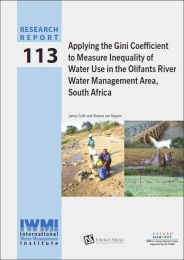Applying the Gini Coefficient to Measure Inequality of Water Use in the Olifants River Water Management Area, South Africa.
Citation:
Cullis, J.; van Koppen, Barbara. 2007. Applying the Gini Coefficient to measure inequality of water use in the Olifants River water management area, South Africa. Colombo, Sri Lanka: IWMI. 19p. (IWMI Research Report 113) [doi: 10.3910/2009.113]
Abstract
The present study explores the application of the Gini Coefficient, which has hitherto only been used for income and land distribution, to quantify the distribution of water resources. The tool is tested in the water-stressed Olifants Water Management Area, in South Africa. Using readily available information on water use registrations, water use estimates, and census data, two versions of the Gini Coefficient are calculated. The first measures the distribution of the allocation of direct water use in rural areas and was estimated at 0.96 in the study area. In other words, 99.5 percent of the rural households are entitled to useonly 5 percent of the available water. The second version calculates the distribution of the indirect benefits of water use in the form of direct employment. This is shown to have a Gini Coefficient of 0.64. Using the Gini Coefficient an assessment was also made of the impacts of different policy scenarios. It was found that by more than doubling the amount of water used by rural households from the current 225 cubic meters per household per annum (m3/hh/annum) to 610 m3/hh/annum, which would enable each household to meet its basic human needs of 50 litres/person/day and irrigate 1,000 square meters (m2), would reduce the Gini Coefficient significantly. Yet, this would only require the large-scale registered users to reduce their current irrigation water use entitlement by 6 percent or the largest ten users to reduce their use by 20 percent each.
ISBN 978-92-9090-665-0
ISSN 1026-0862


